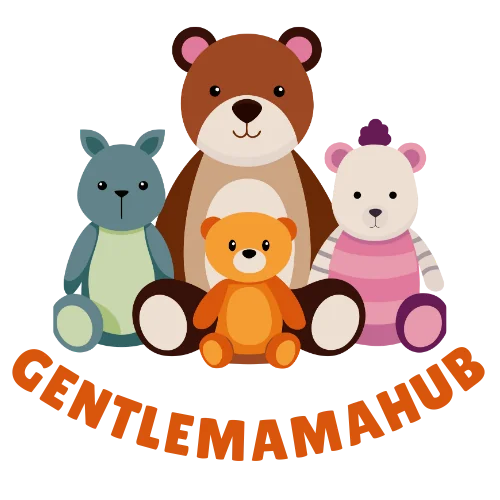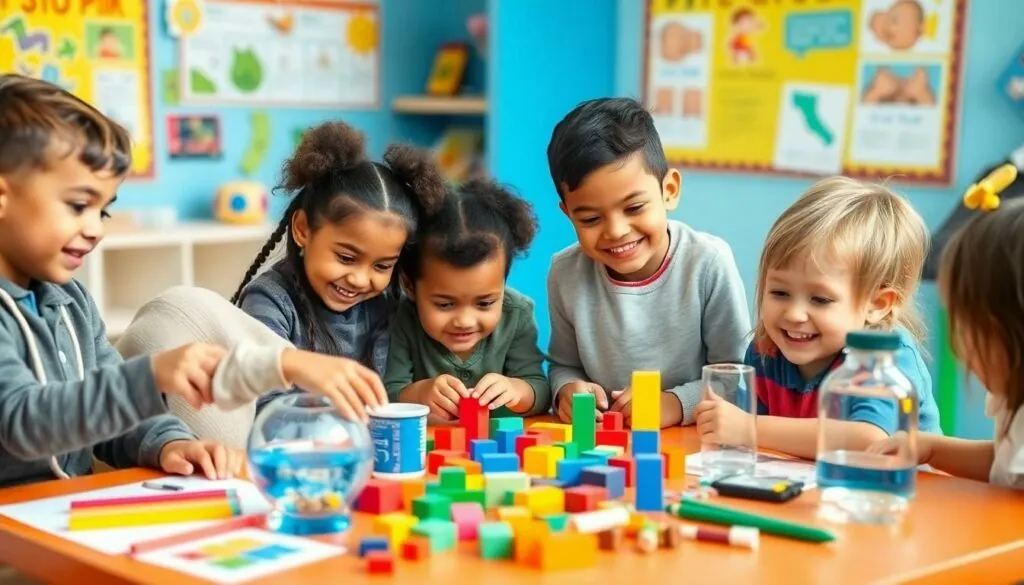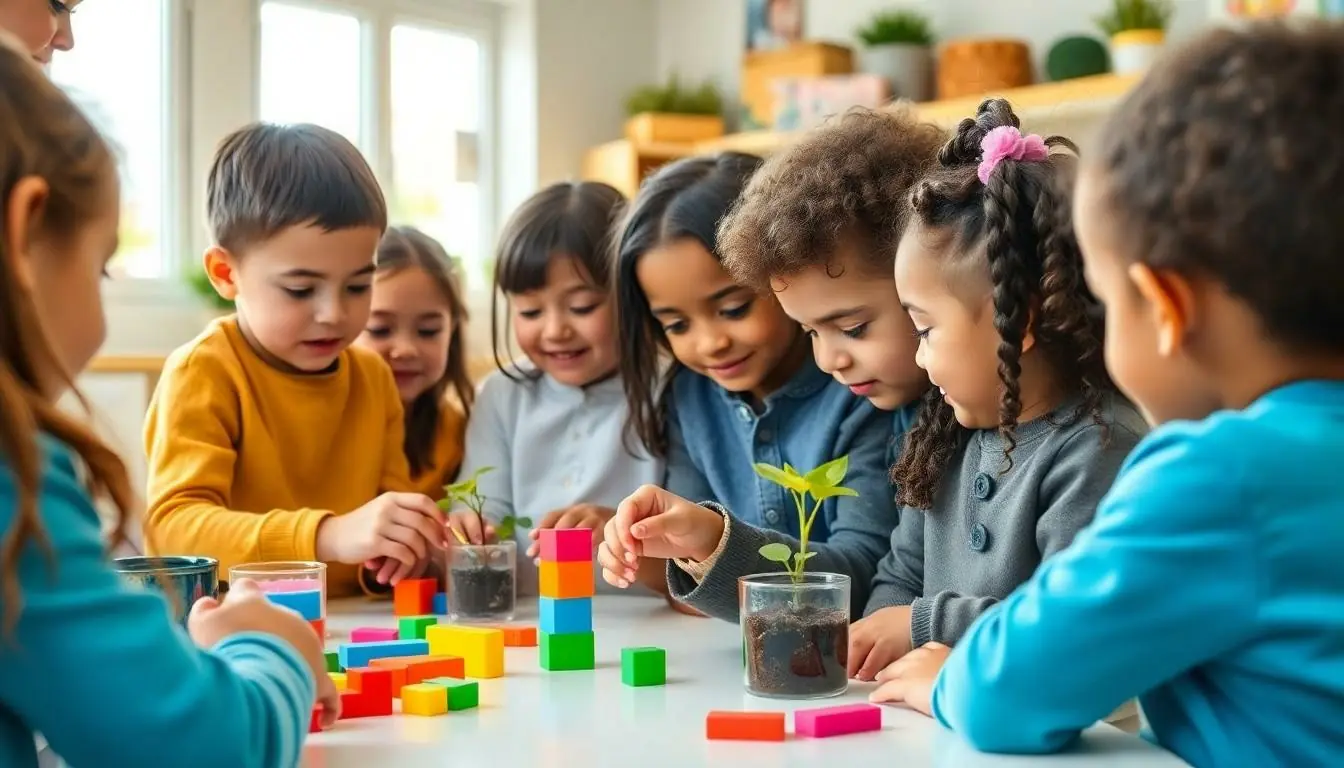Table of Contents
ToggleImagine tiny scientists in lab coats exploring the wonders of science through building blocks and finger painting. That’s exactly what STEM education for preschoolers looks like – minus the lab coats, of course! By introducing Science, Technology, Engineering, and Mathematics at an early age, children develop critical thinking skills while having a blast.
Today’s preschoolers are tomorrow’s innovators and problem solvers. Research shows that early exposure to STEM concepts helps children develop curiosity, creativity and analytical thinking abilities that’ll benefit them throughout their academic journey. It’s not about complex equations or technical jargon – it’s about making learning fun through play-based activities that naturally align with how young minds explore their world.
What Is STEM Learning for Preschoolers
STEM learning for preschoolers integrates Science, Technology, Engineering Mathematics through age-appropriate activities engaging children aged 3-5 years. This educational approach transforms complex concepts into playful experiences that match young children’s natural curiosity developmental stages.
Key Components of Early STEM Education
- Scientific exploration involves hands-on experiments like water play color mixing sink-float activities
- Technology integration uses simple tools such as magnifying glasses digital microscopes tablets for discovery
- Engineering activities focus on building structures with blocks designing simple machines solving physical challenges
- Mathematical concepts emerge through counting sorting pattern recognition measurement activities
Benefits of Early STEM Exposure
- Critical thinking skills develop through problem-solving tasks observation analysis
- Collaboration abilities strengthen as children work together on group projects experiments
- Communication skills improve when children explain their discoveries share findings with peers
- Fine motor development advances through activities like building measuring pouring
- Executive function enhances via planning organizing testing hypotheses
- Cognitive flexibility grows as children explore multiple solutions to challenges
Note: The content maintains continuity with the previous context while expanding on specific aspects of STEM learning for preschoolers.
Age-Appropriate STEM Activities for Preschoolers
STEM activities for preschoolers focus on experiential learning through play-based exploration. These activities incorporate developmentally appropriate materials that spark curiosity and encourage hands-on discovery.
Science Experiments and Discovery
Basic science experiments engage preschoolers through sensory exploration and observation. Children learn about color mixing by combining primary colors with water or paint. Growing plants from seeds in clear containers lets them observe root development and plant growth stages. Simple experiments with floating objects in water teach fundamental physics concepts. Weather tracking activities using picture charts help children understand daily temperature and precipitation patterns. These hands-on investigations introduce scientific processes like observation, prediction, and basic data collection.
Building and Engineering Projects
Engineering activities develop spatial awareness and problem-solving skills in preschoolers. Building blocks, magnetic tiles, and interlocking pieces enable children to create structures while exploring balance and stability. Recycled materials transform into bridges, towers, and vehicles through guided construction projects. Simple machines like ramps and pulleys demonstrate cause-effect relationships. Building challenges with specific goals encourage children to test multiple solutions. These activities integrate fine motor skills with basic engineering principles.
Early Math Concepts Through Play
Math concepts emerge naturally through interactive play experiences. Sorting activities with buttons, beads, or natural materials reinforce classification and counting skills. Pattern creation using colored blocks or shapes introduces sequence recognition. Measuring activities with non-standard units like paper clips teach comparison and measurement basics. Calendar routines incorporate number recognition and counting. Simple graphing activities using pictures track daily weather or favorite foods. These playful approaches make mathematical thinking accessible and engaging for young learners.
Creating a STEM-Friendly Environment at Home
A STEM-friendly home environment encourages exploration through strategically placed materials and dedicated learning spaces. The setup transforms everyday areas into discovery zones where preschoolers engage with STEM concepts naturally.
Essential Materials and Tools
Basic household items form the foundation of a preschool STEM toolkit. Common materials include:
- Measuring Tools: Rulers, measuring cups, kitchen scales
- Building Materials: Wooden blocks, magnetic tiles, interlocking bricks
- Science Equipment: Magnifying glasses, eye droppers, clear containers
- Art Supplies: Safety scissors, recyclable materials, modeling clay
- Math Manipulatives: Counting bears, pattern blocks, sorting cups
- Nature Items: Seeds, leaves, rocks, shells
- Documentation Tools: Simple cameras, notebooks, colored pencils
Store these materials in clear, labeled containers at child height to promote independent access and exploration.
Setting Up Learning Spaces
Designated STEM areas maximize learning opportunities through thoughtful organization:
- Discovery Corner: A table with magnifying glasses and natural specimens
- Building Zone: Open floor space with construction materials
- Science Station: Water-resistant surface for experiments
- Math Center: Low shelves with counting objects and number cards
- Creation Station: Tables with art supplies and recycled materials
- Storage Area: Labeled bins for organizing materials
- Display Space: Walls or boards to showcase projects and observations
Position these areas near natural light sources when possible. Include child-sized furniture to ensure comfort during exploration activities.
Integrating STEM Into Daily Routines
STEM learning opportunities exist in everyday activities preschoolers encounter. Parents transform routine moments into engaging learning experiences through strategic activity selection.
Cooking and Kitchen Science
Kitchen activities provide natural STEM learning experiences for preschoolers. Children practice measurement skills using cups, spoons, and scales while baking cookies or making pancakes. Mixing ingredients demonstrates basic chemistry concepts as children observe state changes when sugar dissolves in water or butter melts. Counting eggs, comparing container sizes, and sequencing recipe steps reinforce mathematical thinking. The kitchen becomes a laboratory where preschoolers explore temperature changes, practice fractions with measuring cups, and learn about time through cooking durations.
Nature Exploration and Observation
Outdoor environments offer rich STEM learning experiences through direct interaction with natural elements. Children classify leaves by shape, size, and color during nature walks. They count petals on flowers, measure plant growth with rulers, and track weather patterns in simple journals. Collecting rocks introduces concepts of weight, texture, and sorting. Observing insects teaches life cycles while building bug hotels develops engineering skills. Gardens serve as living laboratories where preschoolers document plant development, measure rainfall, and investigate soil composition through hands-on exploration.
Best STEM Toys and Resources for Preschoolers
STEM toys enhance learning through hands-on exploration while engaging young minds in scientific discovery. These educational tools transform complex concepts into playful experiences for preschoolers.
Educational Games and Puzzles
Educational STEM games develop critical thinking through interactive play experiences. Pattern matching games like Sequence for Kids introduce basic coding concepts. Number puzzles from companies like Learning Resources strengthen mathematical reasoning skills. Shape-sorting activities enhance spatial awareness while teaching geometric principles. Digital apps such as Endless Numbers combine technology with foundational math concepts. Science-themed memory games help children learn classification skills through matching pairs of animals, plants or weather patterns. Coding toys like Code-a-pillar introduce basic programming logic through sequencing activities. Board games featuring counting spaces, simple addition or pattern recognition reinforce early math skills.
Building Sets and Construction Tools
Construction toys create opportunities for engineering exploration through hands-on building activities. LEGO DUPLO blocks develop fine motor skills while teaching structural concepts. Magnetic building sets like Magna-Tiles allow children to explore geometry through 3D creation. Wooden blocks promote problem-solving as children stack, balance and design structures. Engineering sets from brands like K’NEX Junior introduce simple machines through age-appropriate pieces. Gear toys demonstrate cause and effect relationships through mechanical movement. Building sticks and connectors encourage open-ended construction play. Tool sets with child-safe equipment let preschoolers practice basic engineering skills through pretend building projects.
Supporting STEM Learning Through Questions
Effective questioning techniques enhance preschoolers’ STEM learning experiences by encouraging deeper thinking and exploration. Strategic questions guide children toward discovering solutions while developing critical reasoning skills.
Open-Ended Exploration
Questions that promote open-ended exploration spark curiosity and creative thinking in preschoolers during STEM activities. Teachers start with observation prompts like “What do you notice?” or “How does this work?” to encourage detailed examination. Follow-up questions such as “What happens if…?” and “How else could we…?” invite children to test multiple possibilities. These inquiries create opportunities for children to:
- Investigate cause-effect relationships through hands-on experimentation
- Generate original ideas by exploring different materials
- Document observations using drawings photos or simple charts
- Share discoveries with peers through show-and-tell presentations
- Express predictions about potential outcomes
Problem-Solving Strategies
Strategic questioning helps preschoolers develop systematic approaches to solving STEM challenges. Questions like “What materials do we need?” guide children to plan before taking action. Process-focused inquiries such as “What steps did you take?” encourage reflection on methods used. Key questioning techniques include:
- Breaking down complex tasks into manageable steps
- Comparing different solution approaches
- Identifying patterns in results
- Testing predictions through trial runs
- Evaluating outcomes against initial goals
- Building activities with blocks or recycled materials
- Simple science experiments with everyday items
- Mathematical games involving sorting counting
- Engineering challenges that require creative solutions
- Technology exploration with age-appropriate tools
Conclusion
STEM education in early childhood sets the foundation for lifelong learning and discovery. Through age-appropriate activities toys and thoughtfully designed spaces preschoolers develop essential skills that extend far beyond basic science and math concepts.
Creating a STEM-rich environment at home coupled with strategic questioning techniques empowers young learners to become confident explorers and problem solvers. As children engage with STEM through play they naturally develop critical thinking skills collaboration abilities and creative approaches to challenges.
The journey of STEM learning for preschoolers isn’t just about preparing them for future academic success – it’s about nurturing their natural curiosity and joy of discovery right now. When parents and educators embrace this approach they open doors to endless possibilities in children’s cognitive and social development.





